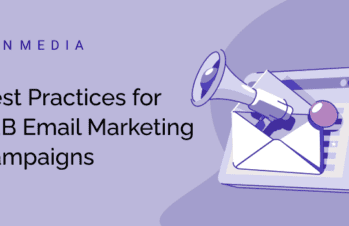There’s nothing like staring at a blank email template to make you want to procrastinate with a few cat videos. Practically every business uses some sort of email marketing – however, it’s a tough thing to get just right.
Think back to the last time you took a look through your promotions tab in Gmail. How many emails did you click on? 1? 5? Any?
If you did open any, how many did you actually read? Now go one step further: Of those, did any make you actually click on a link?
If you’re like most people, your engagement level goes down with each subsequent step. You might open 10 emails, read 3, and click on one or two links. Then the rest of the 150 marketing emails sitting in your inbox languish there for a couple of days or weeks before getting sent to Trash.
In fact, overall click rates for companies that send 16-30 email campaigns per month range from a median of 6.3% to 7%, according to research by Hubspot.
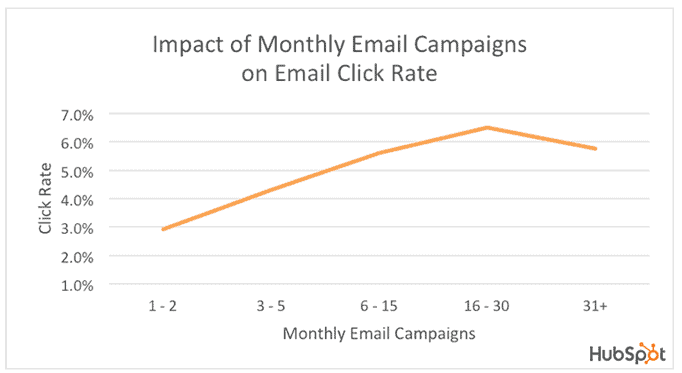
Although that may sound low, it’s not a bad number to use as a benchmark. Plus, the important thing to focus on is not your current open or click rate, but how to make those rates grow over time.
So how do you do that? How do you create email content that actually makes users want to open, read, and maybe even click on one or two of your links?
1. Hone your subject lines.
The importance of subject lines is something we’ve all heard emphasized more times than we can count. What was true in 2008 remains largely true today: Your email subject lines need to be short, concise, and highly specific. Let people know what they’re getting by opening the email.
Let’s run a little test. Say you’re a retailer announcing a major sale. You could say “Huge sale now through next week.” That would probably get you a decent open rate.
But what if instead your subject line read “Stylish bakeware 40% off through next Tuesday”? It’s way more specific, and it will give you a much better open rate – and, likely, better click-through and conversion rates as well.
That’s because the “huge sale” subject line targets people who love shopping – people for whom the simple word “sale” might entice them to take a look at your email. Some of them will be interested in the bakeware that’s currently on sale, and some won’t.
The “stylish bakeware” subject line, on the other hand, targets people who, first, like baking, and second, have a certain modern aesthetic. By emphasizing only the fact that you’re having a sale, you’ll miss many of these baking enthusiasts who might not be planning on spending money at the moment and therefore send that “sale” email – along with tons of others promising generic sales or special values – straight to the Trash bin.
2. Keep it short and to the point.
No matter how great your content is, readers have a limited amount of time that they’re willing to spend with your emails.
That amount will differ, of course, based on the type of email that they’re reading. If it’s a dedicated email – an email that has a single, specific purpose, like advertising a new product line or a one-time event – you want to say what you need to say in as few words as possible, preferably with an image or two.
Take this email from Thrive Market, an organic grocery delivery service:
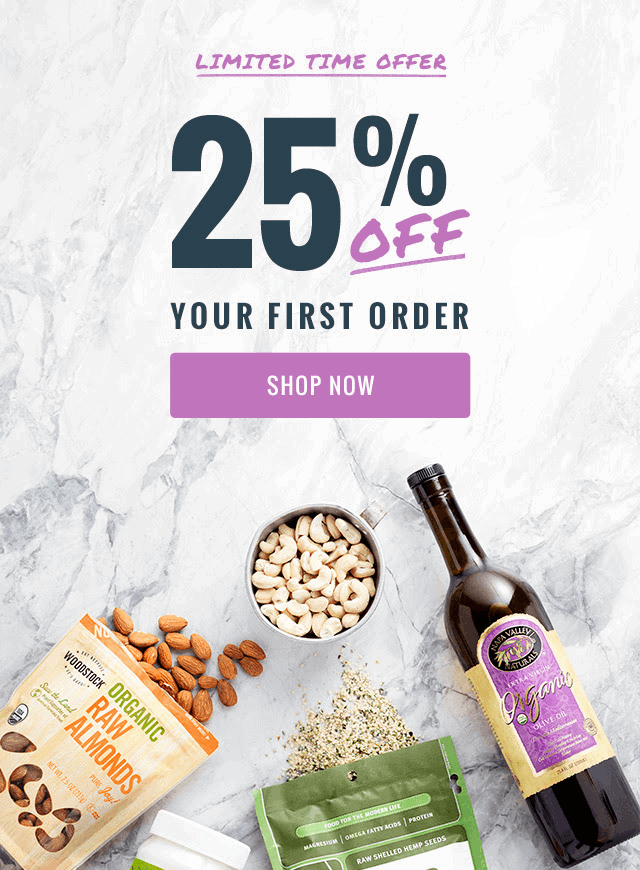
The offer is clear and simple, there’s a large, appealing image, and there are no irrelevant links or blocks of text to clutter up the message.
When you’re writing a newsletter, you’ve got a few more options as far as length and format go. It’s all about knowing your audience: are you writing to intellectuals and thought leaders who want to deep dive into your topics each month? Or are you targeting busy executives who want to be able to get what they need from you by skimming a few short sections?
For Zen Media, it’s the latter. Our newsletter goes out to marketing professionals and C-level executives in a variety of industries. That’s why we break our newsletter up into short, easily digestible sections and include links to our full blog posts and longer content – like this:
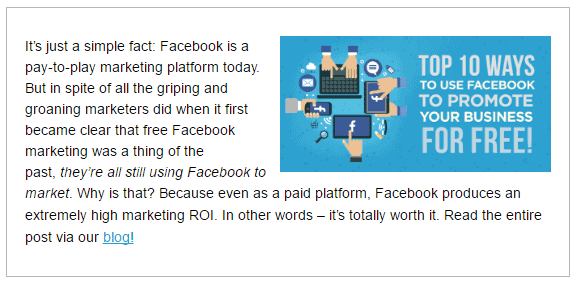
3. Keep your tone conversational and authentic.
Don’t put on your snooty businesswoman voice when you write content for your email campaigns. You want to sound as natural and friendly as possible, while still retaining professionalism and authority.
In these days of ever-increasing personalization, no reader wants to feel like he’s just one of a hundred people reading the same email – even though he knows that to be the case (or possibly one of thousands, depending on your email reach).
Take a look at this newsletter message from our CEO, Shama Hyder:
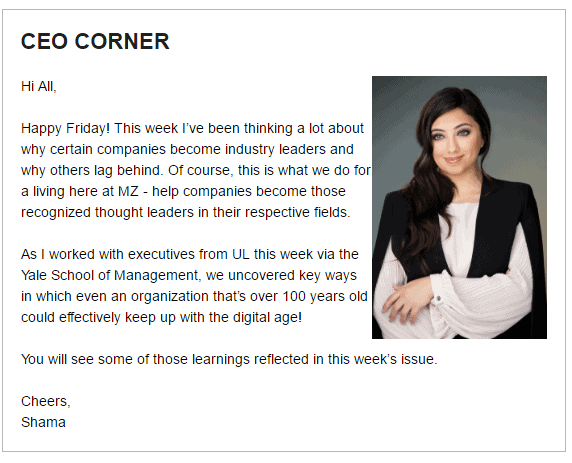
There’s an informal, friendly greeting, simple comments on what she’s been thinking about lately, and a brief intro to what follows in the newsletter. There’s no jargon, no technical talk, and no flowery verbiage.
4. Be OK with giving more than you’ll get, at least at first.
No one likes to be sold to, so look at your email campaigns as a way to stay in touch with your customers and nurture those relationships, rather than as a way to sell to them. What unique things do you have to offer them?
Do you have a different perspective on recent research in your industry? Share it with your list via a dedicated email.
Do you have a funny image or story to share that might brighten people’s day? Include it in your next newsletter.
While you can’t ditch every last bit of self-promotion, you can certainly weight your emails more toward education and information-sharing. This will pay you much greater dividends in the long run: You’ll not only earn subscribers this way, but you’re also more likely to keep the ones you’ve already got.
5. Be deliberate about what you include in your email newsletters.
One easy way to lose readers is to confuse them with random pieces of information all squashed together in a single email.
Often you’ll see this with larger companies that want to use a single newsletter to cover every part of their business. This isn’t such a great idea.
Not only will it result in longer newsletters, which will be less likely to be read, but it will also mean that each week or month, a good amount of the information you include will be irrelevant to many of your subscribers. And that means they’ll soon lose interest in what you have to say.
Instead, focus your newsletter on a single aspect of what you do. If you need to cover several different topics on a regular basis, create dedicated newsletters for each topic – one for marketing news, one for product updates, etc.
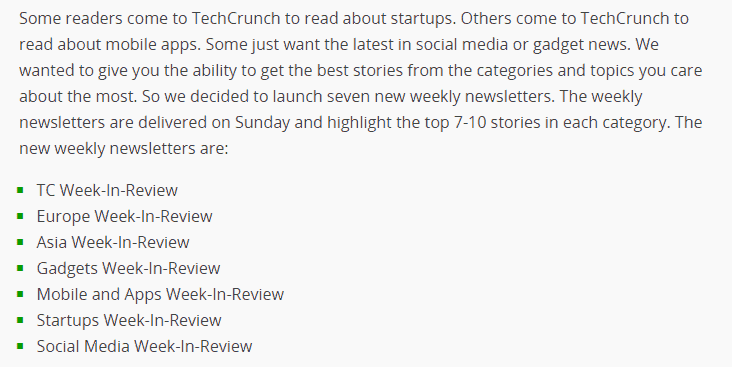
6. Get to know your audience.
How well do you know your email audience? For example, one of our clients, EyeCare 2020, is a New Jersey-based opthalmologist that specializes in LASIK and cataract surgery.
For a business like this, it’s fairly easy to discern who the audience is. They’re mainly local to New Jersey, and many of them are current patients who’ve had some kind of eye surgery at EyeCare. Other audience segments are prospective patients – people who live close enough to get care at EyeCare 2020 – and people who want to learn more about specific eye issues, but don’t live near the office.
With businesses that target a varied or wider audience, it may take some more time to figure out who you’re writing for – but then, that’s what analytics tools are for.
Check your email analytics frequently and note which emails are performing better than others. Then – and this is the most important part – act on that knowledge.
7. Keep your Call-to-Action simple and obvious.
Calls to action are an important part of any email campaign, but their degree of importance can vary based on the type of email you’re sending.
If it’s a transactional email, for example – one that is automatically triggered when a user takes a specific action – the call to action could be the whole point of the email. Let’s say a user abandons their shopping cart on your ecommerce site. You could create a triggered email that goes out to that user to remind them about what they left behind.
In a newsletter or promotional email, however, you might have several calls to action. Maybe you’re announcing a webinar and want people to sign up. You’ve also got a new report and a few new blog posts to share.
Instead of giving each of these calls to action equal weight, which can result in a cluttered, disorganized feel, choose just one to focus on. Take a look at this newsletter from The Bitter Southerner, an online literary and folklore publication.

Front and center is a link to one of their new stories, with a design that differentiates it from the rest of the newsletter and makes it stand out. Note, too, that this free-to-read story holds precedence over the link to their General Store, where you can actually pay to buy something. Information first, promotion second.
8. Less is almost always more.
If you’re a fan of William Faulkner – or Allen Ginsberg, or Eudora Welty, or any of several other major authors to whom this quote has been attributed – you might know this quote about writing: “In writing, you must kill your darlings.” In other words, in order to be a strong and effective writer, you must be able to edit yourself mercilessly.
Now, an email newsletter is no Absalom! Absalom!, but the same truth applies.
When putting together your email campaigns, there are always going to be elements that must be cut no matter how much you want to keep them. That could be something as small as a turn of phrase that you put tons of thought into but that just isn’t working. Or it could mean deleting an entire section because the email’s just getting too long.
Whatever it means, be swift and confident with your pen – er, backspace button. You’ll almost always have another opportunity to highlight the blog post, event, or report that you couldn’t fit in this time.
9. Don’t take your readers for granted.
Maybe you’re doing an amazing job with your email campaigns. Your open rates are consistently high, your click-through rates keep growing, and you feel like you have this email thing down. This is the case with many of our clients, who are already successful but want to take that success to the next level.
It’s important to remember that no matter how loyal your followers seem to be, you have to continue to earn their time and trust. There’s always room for improvement, so don’t get complacent.
There are hundreds of other emails vying for your readers’ attention every time they open their inbox. Yours have to keep offering them something special if they’re going to continue opening them.
10. Remember that every email is a chance to strengthen your relationship with your readers.
Your readers are individuals, and they have their own personal reasons for their interest in your company.
Sure, each person is part of one of your target demographics – mothers of young children, or city-dwelling Millennials – but their relationship with your business is unique. If you can focus on nurturing those relationships, your emails will automatically become more engaging, more compelling, and ultimately, provide a higher ROI.







